Demand & Capacity Management in Hospitality & Tourism Industry
VerifiedAdded on 2023/06/04
|8
|1807
|200
Essay
AI Summary
This essay explores strategies for managing customer demand and service capacity within the hospitality and tourism industry, addressing the challenges faced by service managers. It examines methods for altering demand through reservation systems and off-peak promotions, as well as managing capacity by maximizing efficiency and utilizing part-time employees. The paper discusses the complexities of distribution channels in the digital age, highlighting the impact of online social networks and mobile technologies. It also analyzes the promotion mix, considering factors like service offerings, installation fees, and promotional channels, using a mobile app example to illustrate advertising methods and sales promotion techniques. Furthermore, the essay emphasizes the importance of local area marketing, including engaging with locals on social media and gathering testimonials, to ensure effective product or service promotion within specific communities. The conclusion underscores the need for service executives to adopt practical approaches to managing demand and capacity, employing promising distribution channels, promotion mix strategies, and promotion budget plans for successful marketing outcomes.
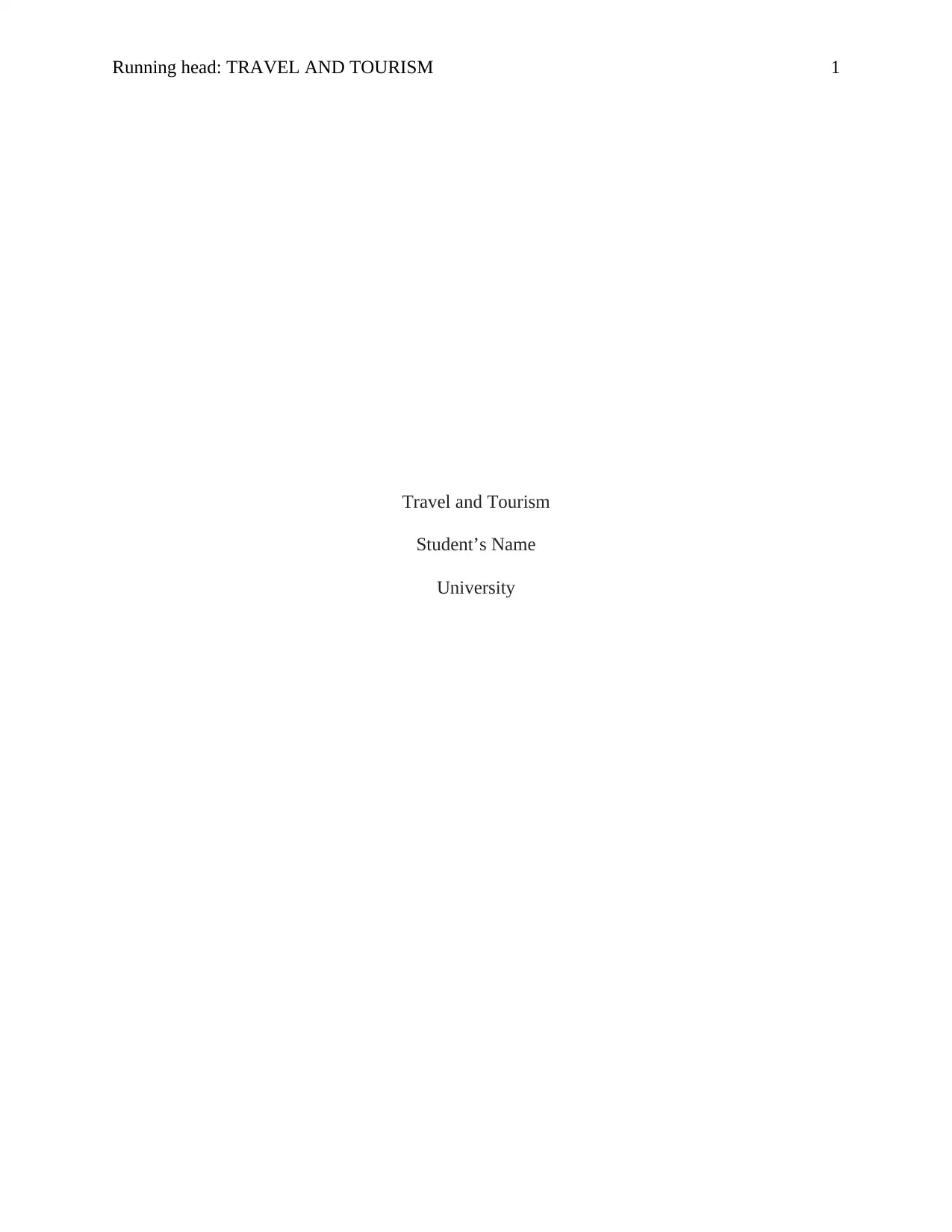
Running head: TRAVEL AND TOURISM 1
Travel and Tourism
Student’s Name
University
Travel and Tourism
Student’s Name
University
Paraphrase This Document
Need a fresh take? Get an instant paraphrase of this document with our AI Paraphraser
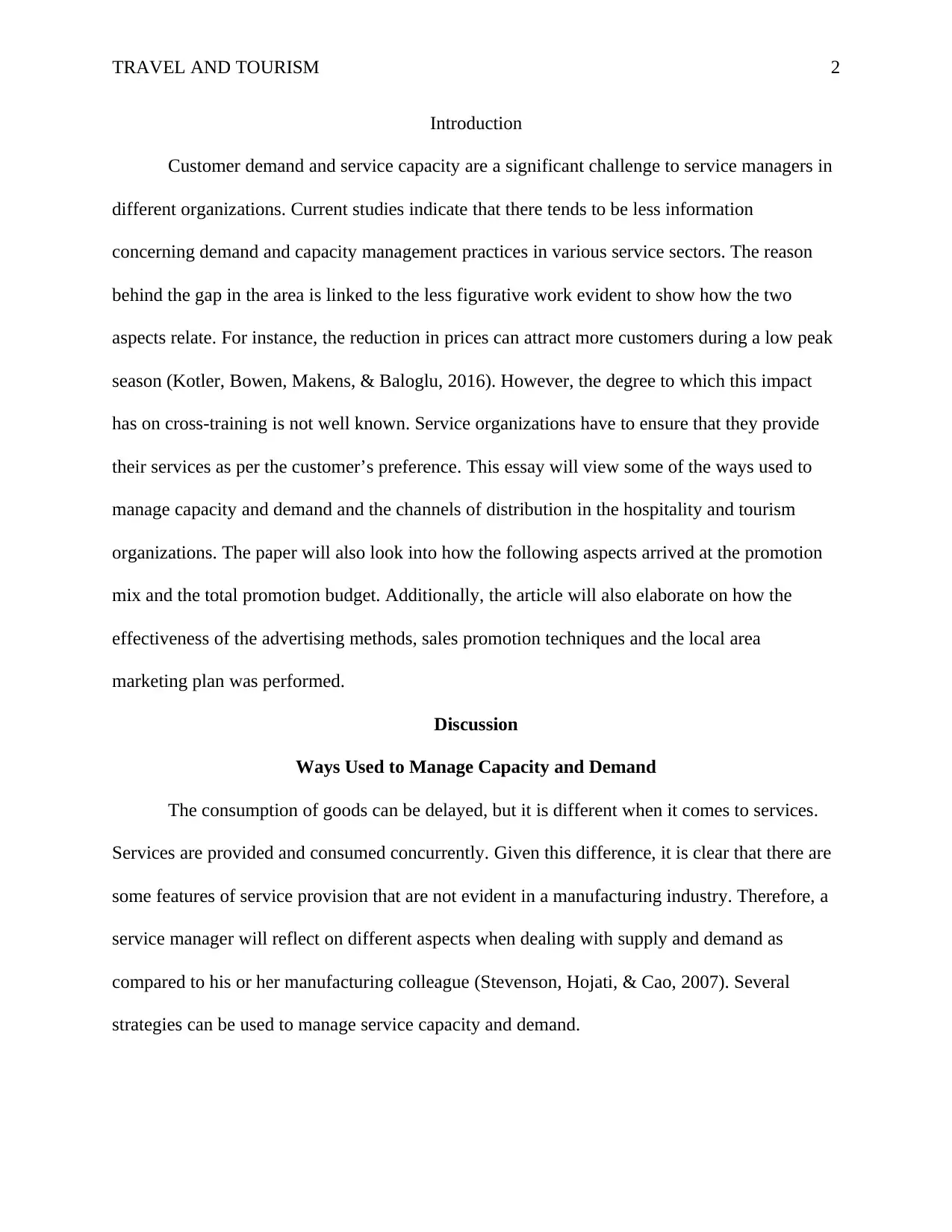
TRAVEL AND TOURISM 2
Introduction
Customer demand and service capacity are a significant challenge to service managers in
different organizations. Current studies indicate that there tends to be less information
concerning demand and capacity management practices in various service sectors. The reason
behind the gap in the area is linked to the less figurative work evident to show how the two
aspects relate. For instance, the reduction in prices can attract more customers during a low peak
season (Kotler, Bowen, Makens, & Baloglu, 2016). However, the degree to which this impact
has on cross-training is not well known. Service organizations have to ensure that they provide
their services as per the customer’s preference. This essay will view some of the ways used to
manage capacity and demand and the channels of distribution in the hospitality and tourism
organizations. The paper will also look into how the following aspects arrived at the promotion
mix and the total promotion budget. Additionally, the article will also elaborate on how the
effectiveness of the advertising methods, sales promotion techniques and the local area
marketing plan was performed.
Discussion
Ways Used to Manage Capacity and Demand
The consumption of goods can be delayed, but it is different when it comes to services.
Services are provided and consumed concurrently. Given this difference, it is clear that there are
some features of service provision that are not evident in a manufacturing industry. Therefore, a
service manager will reflect on different aspects when dealing with supply and demand as
compared to his or her manufacturing colleague (Stevenson, Hojati, & Cao, 2007). Several
strategies can be used to manage service capacity and demand.
Introduction
Customer demand and service capacity are a significant challenge to service managers in
different organizations. Current studies indicate that there tends to be less information
concerning demand and capacity management practices in various service sectors. The reason
behind the gap in the area is linked to the less figurative work evident to show how the two
aspects relate. For instance, the reduction in prices can attract more customers during a low peak
season (Kotler, Bowen, Makens, & Baloglu, 2016). However, the degree to which this impact
has on cross-training is not well known. Service organizations have to ensure that they provide
their services as per the customer’s preference. This essay will view some of the ways used to
manage capacity and demand and the channels of distribution in the hospitality and tourism
organizations. The paper will also look into how the following aspects arrived at the promotion
mix and the total promotion budget. Additionally, the article will also elaborate on how the
effectiveness of the advertising methods, sales promotion techniques and the local area
marketing plan was performed.
Discussion
Ways Used to Manage Capacity and Demand
The consumption of goods can be delayed, but it is different when it comes to services.
Services are provided and consumed concurrently. Given this difference, it is clear that there are
some features of service provision that are not evident in a manufacturing industry. Therefore, a
service manager will reflect on different aspects when dealing with supply and demand as
compared to his or her manufacturing colleague (Stevenson, Hojati, & Cao, 2007). Several
strategies can be used to manage service capacity and demand.
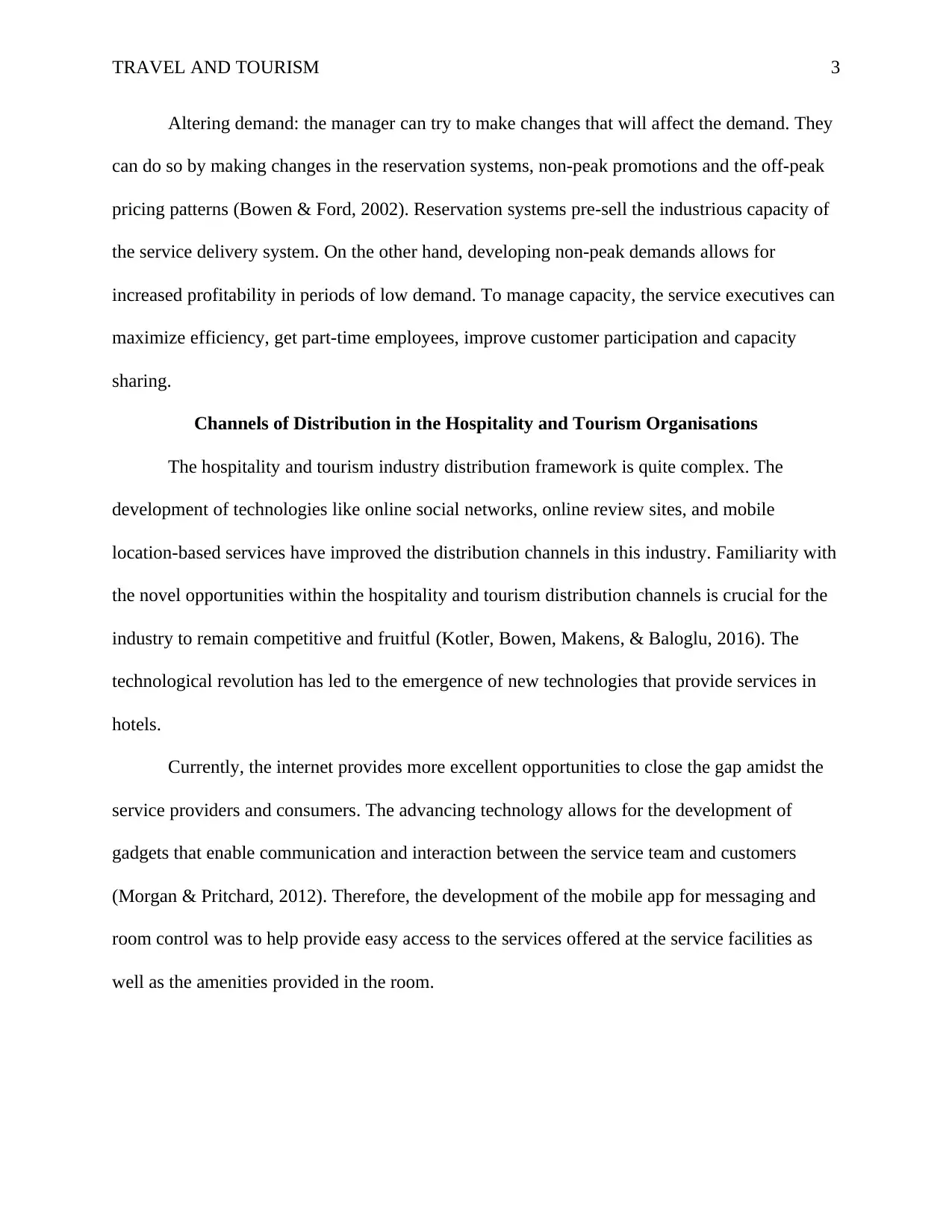
TRAVEL AND TOURISM 3
Altering demand: the manager can try to make changes that will affect the demand. They
can do so by making changes in the reservation systems, non-peak promotions and the off-peak
pricing patterns (Bowen & Ford, 2002). Reservation systems pre-sell the industrious capacity of
the service delivery system. On the other hand, developing non-peak demands allows for
increased profitability in periods of low demand. To manage capacity, the service executives can
maximize efficiency, get part-time employees, improve customer participation and capacity
sharing.
Channels of Distribution in the Hospitality and Tourism Organisations
The hospitality and tourism industry distribution framework is quite complex. The
development of technologies like online social networks, online review sites, and mobile
location-based services have improved the distribution channels in this industry. Familiarity with
the novel opportunities within the hospitality and tourism distribution channels is crucial for the
industry to remain competitive and fruitful (Kotler, Bowen, Makens, & Baloglu, 2016). The
technological revolution has led to the emergence of new technologies that provide services in
hotels.
Currently, the internet provides more excellent opportunities to close the gap amidst the
service providers and consumers. The advancing technology allows for the development of
gadgets that enable communication and interaction between the service team and customers
(Morgan & Pritchard, 2012). Therefore, the development of the mobile app for messaging and
room control was to help provide easy access to the services offered at the service facilities as
well as the amenities provided in the room.
Altering demand: the manager can try to make changes that will affect the demand. They
can do so by making changes in the reservation systems, non-peak promotions and the off-peak
pricing patterns (Bowen & Ford, 2002). Reservation systems pre-sell the industrious capacity of
the service delivery system. On the other hand, developing non-peak demands allows for
increased profitability in periods of low demand. To manage capacity, the service executives can
maximize efficiency, get part-time employees, improve customer participation and capacity
sharing.
Channels of Distribution in the Hospitality and Tourism Organisations
The hospitality and tourism industry distribution framework is quite complex. The
development of technologies like online social networks, online review sites, and mobile
location-based services have improved the distribution channels in this industry. Familiarity with
the novel opportunities within the hospitality and tourism distribution channels is crucial for the
industry to remain competitive and fruitful (Kotler, Bowen, Makens, & Baloglu, 2016). The
technological revolution has led to the emergence of new technologies that provide services in
hotels.
Currently, the internet provides more excellent opportunities to close the gap amidst the
service providers and consumers. The advancing technology allows for the development of
gadgets that enable communication and interaction between the service team and customers
(Morgan & Pritchard, 2012). Therefore, the development of the mobile app for messaging and
room control was to help provide easy access to the services offered at the service facilities as
well as the amenities provided in the room.
⊘ This is a preview!⊘
Do you want full access?
Subscribe today to unlock all pages.

Trusted by 1+ million students worldwide
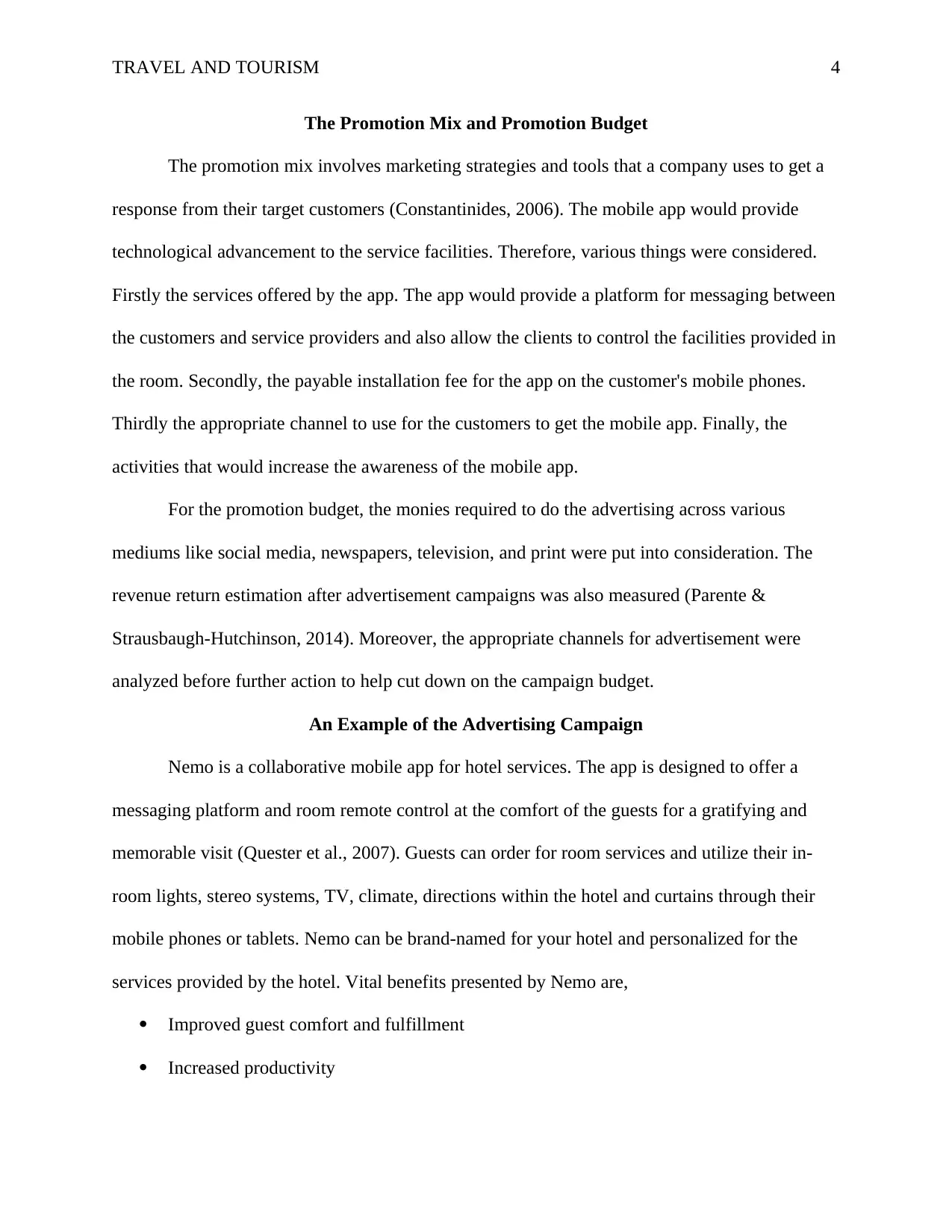
TRAVEL AND TOURISM 4
The Promotion Mix and Promotion Budget
The promotion mix involves marketing strategies and tools that a company uses to get a
response from their target customers (Constantinides, 2006). The mobile app would provide
technological advancement to the service facilities. Therefore, various things were considered.
Firstly the services offered by the app. The app would provide a platform for messaging between
the customers and service providers and also allow the clients to control the facilities provided in
the room. Secondly, the payable installation fee for the app on the customer's mobile phones.
Thirdly the appropriate channel to use for the customers to get the mobile app. Finally, the
activities that would increase the awareness of the mobile app.
For the promotion budget, the monies required to do the advertising across various
mediums like social media, newspapers, television, and print were put into consideration. The
revenue return estimation after advertisement campaigns was also measured (Parente &
Strausbaugh-Hutchinson, 2014). Moreover, the appropriate channels for advertisement were
analyzed before further action to help cut down on the campaign budget.
An Example of the Advertising Campaign
Nemo is a collaborative mobile app for hotel services. The app is designed to offer a
messaging platform and room remote control at the comfort of the guests for a gratifying and
memorable visit (Quester et al., 2007). Guests can order for room services and utilize their in-
room lights, stereo systems, TV, climate, directions within the hotel and curtains through their
mobile phones or tablets. Nemo can be brand-named for your hotel and personalized for the
services provided by the hotel. Vital benefits presented by Nemo are,
Improved guest comfort and fulfillment
Increased productivity
The Promotion Mix and Promotion Budget
The promotion mix involves marketing strategies and tools that a company uses to get a
response from their target customers (Constantinides, 2006). The mobile app would provide
technological advancement to the service facilities. Therefore, various things were considered.
Firstly the services offered by the app. The app would provide a platform for messaging between
the customers and service providers and also allow the clients to control the facilities provided in
the room. Secondly, the payable installation fee for the app on the customer's mobile phones.
Thirdly the appropriate channel to use for the customers to get the mobile app. Finally, the
activities that would increase the awareness of the mobile app.
For the promotion budget, the monies required to do the advertising across various
mediums like social media, newspapers, television, and print were put into consideration. The
revenue return estimation after advertisement campaigns was also measured (Parente &
Strausbaugh-Hutchinson, 2014). Moreover, the appropriate channels for advertisement were
analyzed before further action to help cut down on the campaign budget.
An Example of the Advertising Campaign
Nemo is a collaborative mobile app for hotel services. The app is designed to offer a
messaging platform and room remote control at the comfort of the guests for a gratifying and
memorable visit (Quester et al., 2007). Guests can order for room services and utilize their in-
room lights, stereo systems, TV, climate, directions within the hotel and curtains through their
mobile phones or tablets. Nemo can be brand-named for your hotel and personalized for the
services provided by the hotel. Vital benefits presented by Nemo are,
Improved guest comfort and fulfillment
Increased productivity
Paraphrase This Document
Need a fresh take? Get an instant paraphrase of this document with our AI Paraphraser
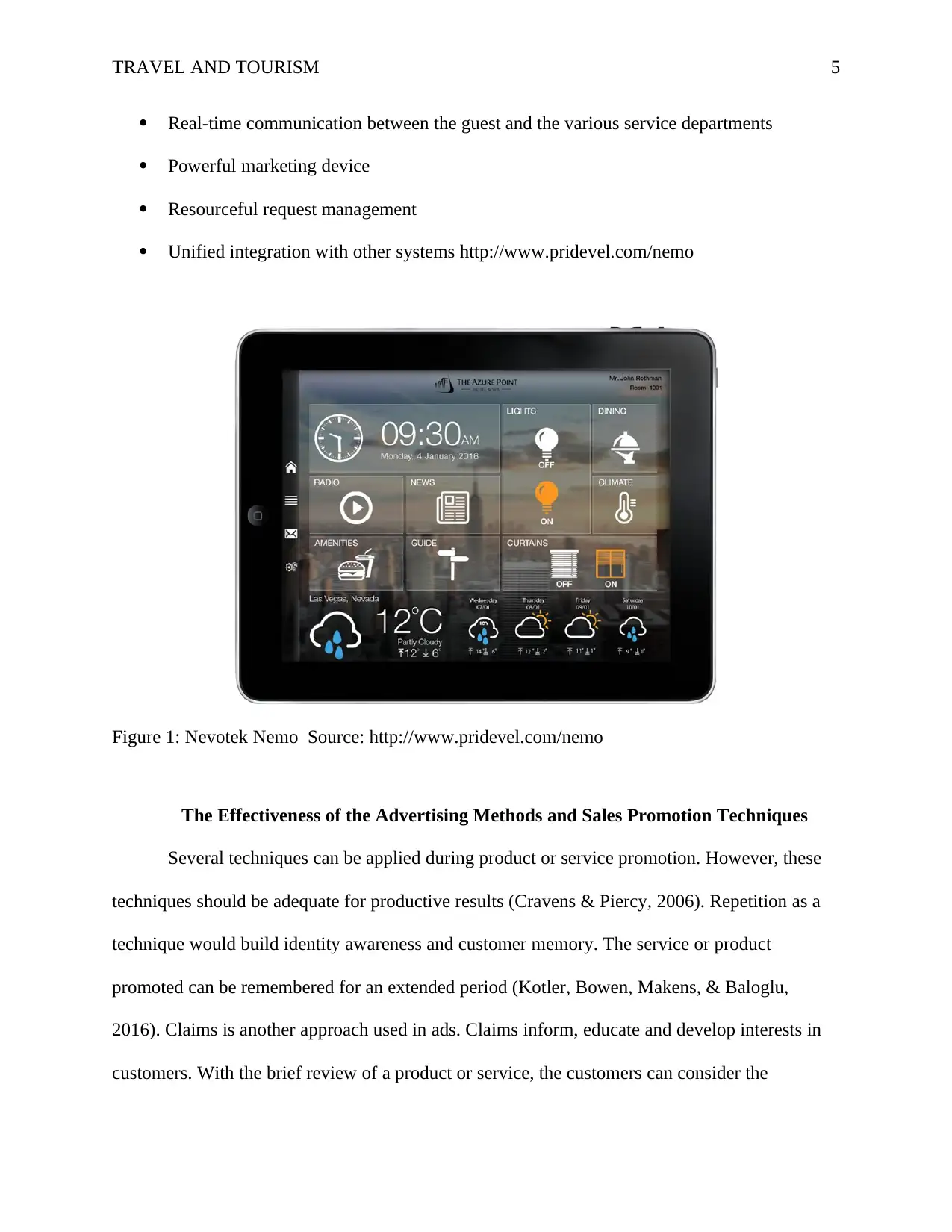
TRAVEL AND TOURISM 5
Real-time communication between the guest and the various service departments
Powerful marketing device
Resourceful request management
Unified integration with other systems http://www.pridevel.com/nemo
Figure 1: Nevotek Nemo Source: http://www.pridevel.com/nemo
The Effectiveness of the Advertising Methods and Sales Promotion Techniques
Several techniques can be applied during product or service promotion. However, these
techniques should be adequate for productive results (Cravens & Piercy, 2006). Repetition as a
technique would build identity awareness and customer memory. The service or product
promoted can be remembered for an extended period (Kotler, Bowen, Makens, & Baloglu,
2016). Claims is another approach used in ads. Claims inform, educate and develop interests in
customers. With the brief review of a product or service, the customers can consider the
Real-time communication between the guest and the various service departments
Powerful marketing device
Resourceful request management
Unified integration with other systems http://www.pridevel.com/nemo
Figure 1: Nevotek Nemo Source: http://www.pridevel.com/nemo
The Effectiveness of the Advertising Methods and Sales Promotion Techniques
Several techniques can be applied during product or service promotion. However, these
techniques should be adequate for productive results (Cravens & Piercy, 2006). Repetition as a
technique would build identity awareness and customer memory. The service or product
promoted can be remembered for an extended period (Kotler, Bowen, Makens, & Baloglu,
2016). Claims is another approach used in ads. Claims inform, educate and develop interests in
customers. With the brief review of a product or service, the customers can consider the
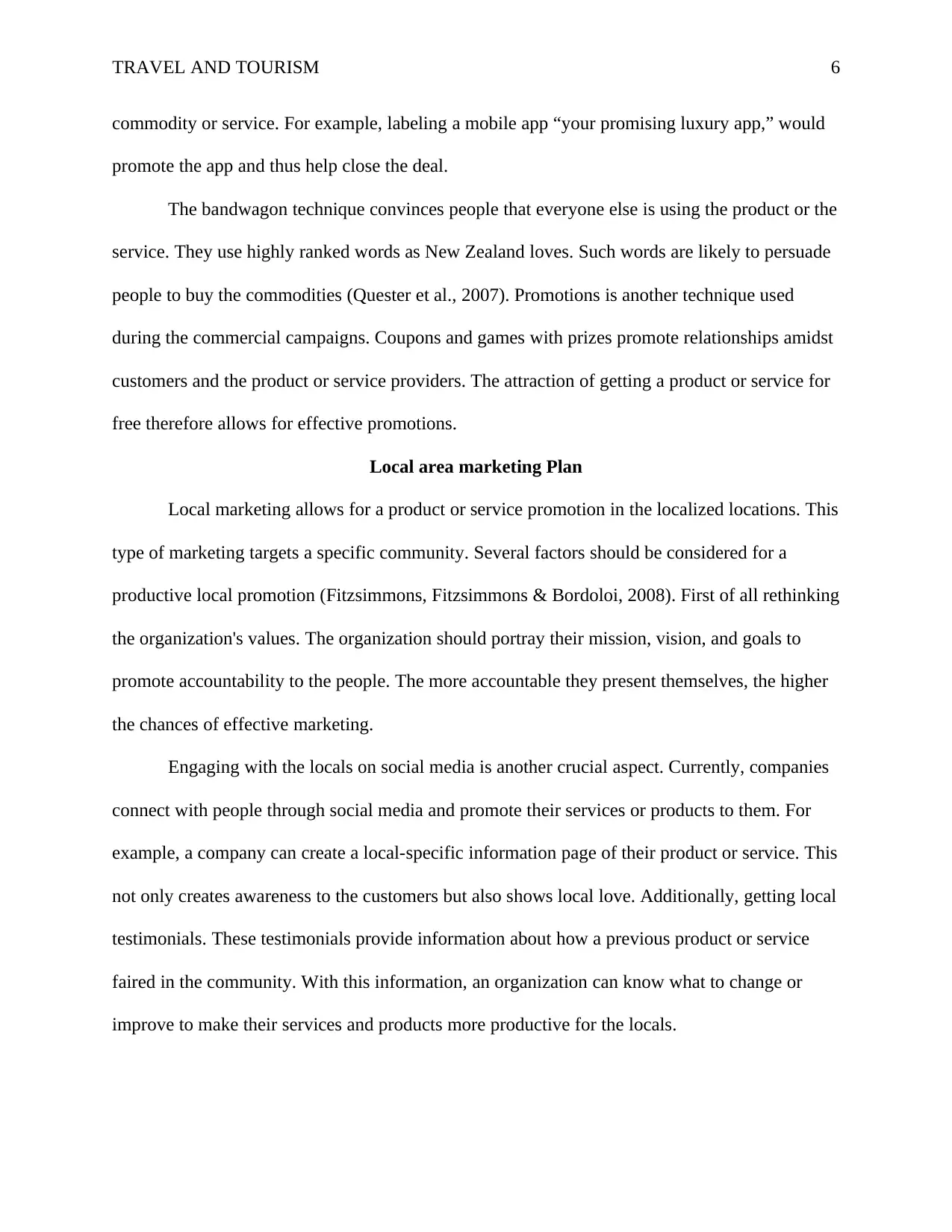
TRAVEL AND TOURISM 6
commodity or service. For example, labeling a mobile app “your promising luxury app,” would
promote the app and thus help close the deal.
The bandwagon technique convinces people that everyone else is using the product or the
service. They use highly ranked words as New Zealand loves. Such words are likely to persuade
people to buy the commodities (Quester et al., 2007). Promotions is another technique used
during the commercial campaigns. Coupons and games with prizes promote relationships amidst
customers and the product or service providers. The attraction of getting a product or service for
free therefore allows for effective promotions.
Local area marketing Plan
Local marketing allows for a product or service promotion in the localized locations. This
type of marketing targets a specific community. Several factors should be considered for a
productive local promotion (Fitzsimmons, Fitzsimmons & Bordoloi, 2008). First of all rethinking
the organization's values. The organization should portray their mission, vision, and goals to
promote accountability to the people. The more accountable they present themselves, the higher
the chances of effective marketing.
Engaging with the locals on social media is another crucial aspect. Currently, companies
connect with people through social media and promote their services or products to them. For
example, a company can create a local-specific information page of their product or service. This
not only creates awareness to the customers but also shows local love. Additionally, getting local
testimonials. These testimonials provide information about how a previous product or service
faired in the community. With this information, an organization can know what to change or
improve to make their services and products more productive for the locals.
commodity or service. For example, labeling a mobile app “your promising luxury app,” would
promote the app and thus help close the deal.
The bandwagon technique convinces people that everyone else is using the product or the
service. They use highly ranked words as New Zealand loves. Such words are likely to persuade
people to buy the commodities (Quester et al., 2007). Promotions is another technique used
during the commercial campaigns. Coupons and games with prizes promote relationships amidst
customers and the product or service providers. The attraction of getting a product or service for
free therefore allows for effective promotions.
Local area marketing Plan
Local marketing allows for a product or service promotion in the localized locations. This
type of marketing targets a specific community. Several factors should be considered for a
productive local promotion (Fitzsimmons, Fitzsimmons & Bordoloi, 2008). First of all rethinking
the organization's values. The organization should portray their mission, vision, and goals to
promote accountability to the people. The more accountable they present themselves, the higher
the chances of effective marketing.
Engaging with the locals on social media is another crucial aspect. Currently, companies
connect with people through social media and promote their services or products to them. For
example, a company can create a local-specific information page of their product or service. This
not only creates awareness to the customers but also shows local love. Additionally, getting local
testimonials. These testimonials provide information about how a previous product or service
faired in the community. With this information, an organization can know what to change or
improve to make their services and products more productive for the locals.
⊘ This is a preview!⊘
Do you want full access?
Subscribe today to unlock all pages.

Trusted by 1+ million students worldwide
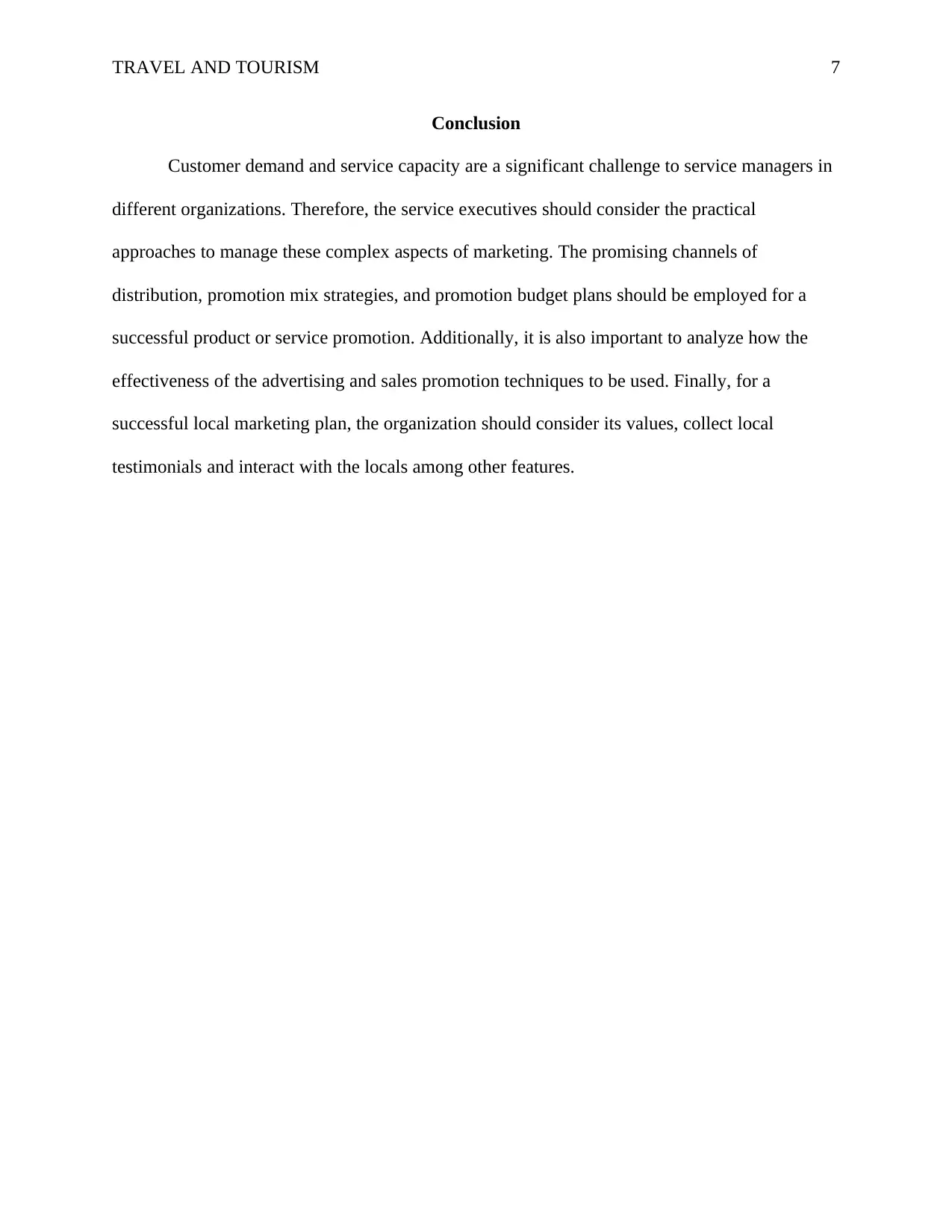
TRAVEL AND TOURISM 7
Conclusion
Customer demand and service capacity are a significant challenge to service managers in
different organizations. Therefore, the service executives should consider the practical
approaches to manage these complex aspects of marketing. The promising channels of
distribution, promotion mix strategies, and promotion budget plans should be employed for a
successful product or service promotion. Additionally, it is also important to analyze how the
effectiveness of the advertising and sales promotion techniques to be used. Finally, for a
successful local marketing plan, the organization should consider its values, collect local
testimonials and interact with the locals among other features.
Conclusion
Customer demand and service capacity are a significant challenge to service managers in
different organizations. Therefore, the service executives should consider the practical
approaches to manage these complex aspects of marketing. The promising channels of
distribution, promotion mix strategies, and promotion budget plans should be employed for a
successful product or service promotion. Additionally, it is also important to analyze how the
effectiveness of the advertising and sales promotion techniques to be used. Finally, for a
successful local marketing plan, the organization should consider its values, collect local
testimonials and interact with the locals among other features.
Paraphrase This Document
Need a fresh take? Get an instant paraphrase of this document with our AI Paraphraser
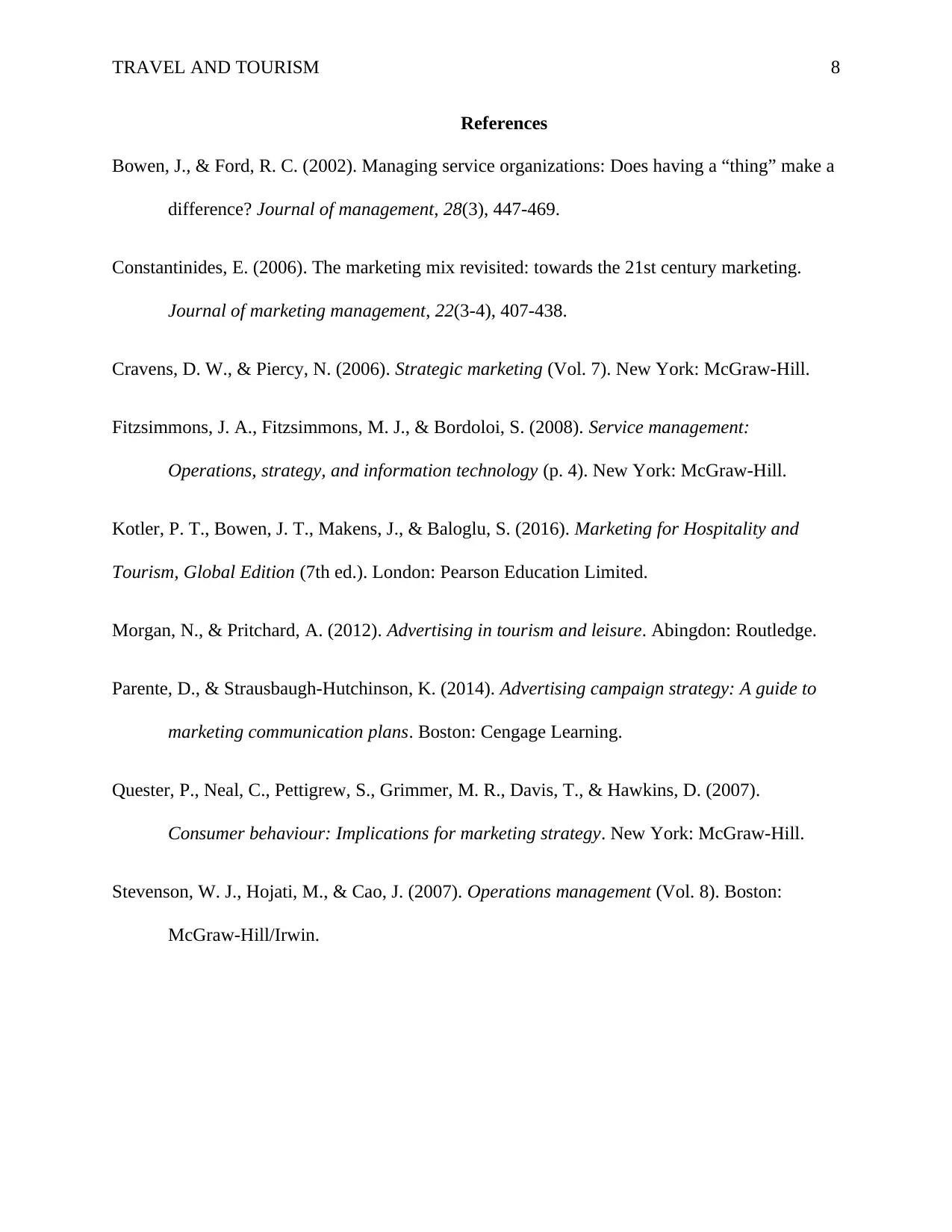
TRAVEL AND TOURISM 8
References
Bowen, J., & Ford, R. C. (2002). Managing service organizations: Does having a “thing” make a
difference? Journal of management, 28(3), 447-469.
Constantinides, E. (2006). The marketing mix revisited: towards the 21st century marketing.
Journal of marketing management, 22(3-4), 407-438.
Cravens, D. W., & Piercy, N. (2006). Strategic marketing (Vol. 7). New York: McGraw-Hill.
Fitzsimmons, J. A., Fitzsimmons, M. J., & Bordoloi, S. (2008). Service management:
Operations, strategy, and information technology (p. 4). New York: McGraw-Hill.
Kotler, P. T., Bowen, J. T., Makens, J., & Baloglu, S. (2016). Marketing for Hospitality and
Tourism, Global Edition (7th ed.). London: Pearson Education Limited.
Morgan, N., & Pritchard, A. (2012). Advertising in tourism and leisure. Abingdon: Routledge.
Parente, D., & Strausbaugh-Hutchinson, K. (2014). Advertising campaign strategy: A guide to
marketing communication plans. Boston: Cengage Learning.
Quester, P., Neal, C., Pettigrew, S., Grimmer, M. R., Davis, T., & Hawkins, D. (2007).
Consumer behaviour: Implications for marketing strategy. New York: McGraw-Hill.
Stevenson, W. J., Hojati, M., & Cao, J. (2007). Operations management (Vol. 8). Boston:
McGraw-Hill/Irwin.
References
Bowen, J., & Ford, R. C. (2002). Managing service organizations: Does having a “thing” make a
difference? Journal of management, 28(3), 447-469.
Constantinides, E. (2006). The marketing mix revisited: towards the 21st century marketing.
Journal of marketing management, 22(3-4), 407-438.
Cravens, D. W., & Piercy, N. (2006). Strategic marketing (Vol. 7). New York: McGraw-Hill.
Fitzsimmons, J. A., Fitzsimmons, M. J., & Bordoloi, S. (2008). Service management:
Operations, strategy, and information technology (p. 4). New York: McGraw-Hill.
Kotler, P. T., Bowen, J. T., Makens, J., & Baloglu, S. (2016). Marketing for Hospitality and
Tourism, Global Edition (7th ed.). London: Pearson Education Limited.
Morgan, N., & Pritchard, A. (2012). Advertising in tourism and leisure. Abingdon: Routledge.
Parente, D., & Strausbaugh-Hutchinson, K. (2014). Advertising campaign strategy: A guide to
marketing communication plans. Boston: Cengage Learning.
Quester, P., Neal, C., Pettigrew, S., Grimmer, M. R., Davis, T., & Hawkins, D. (2007).
Consumer behaviour: Implications for marketing strategy. New York: McGraw-Hill.
Stevenson, W. J., Hojati, M., & Cao, J. (2007). Operations management (Vol. 8). Boston:
McGraw-Hill/Irwin.
1 out of 8
Related Documents
Your All-in-One AI-Powered Toolkit for Academic Success.
+13062052269
info@desklib.com
Available 24*7 on WhatsApp / Email
![[object Object]](/_next/static/media/star-bottom.7253800d.svg)
Unlock your academic potential
Copyright © 2020–2025 A2Z Services. All Rights Reserved. Developed and managed by ZUCOL.



